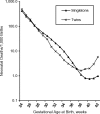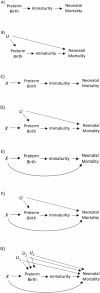On the pitfalls of adjusting for gestational age at birth
- PMID: 21946386
- PMCID: PMC3243938
- DOI: 10.1093/aje/kwr230
On the pitfalls of adjusting for gestational age at birth
Abstract
Preterm delivery is a powerful predictor of newborn morbidity and mortality. Such problems are due to not only immaturity but also the pathologic factors (such as infection) that cause early delivery. The understanding of these underlying pathologic factors is incomplete at best. To the extent that unmeasured pathologies triggering preterm delivery also directly harm the fetus, they will confound the association of early delivery with neonatal outcomes. This, in turn, complicates studies of newborn outcomes more generally. When investigators analyze the association of risk factors with neonatal outcomes, adjustment for gestational age as a mediating variable will lead to bias. In the language of directed acyclic graphs, gestational age is a collider. The theoretical basis for colliders has been well described, and gestational age has recently been acknowledged as a possible collider. However, the impact of this problem, as well as its implications for perinatal research, has not been fully appreciated. The authors discuss the evidence for confounding and present simulations to explore how much bias is produced by adjustments for gestational age when estimating direct effects. Under plausible conditions, frank reversal of exposure-outcome associations can occur. When the purpose is causal inference, there are few settings in which adjustment for gestational age can be justified.
Figures


References
-
- Romero R. Prenatal medicine: the child is the father of the man. 1996. J Matern Fetal Neonatal Med. 2009;22(8):636–639. - PubMed
-
- VanderWeele TJ, Hernández-Diaz S. Is there a direct effect of pre-eclampsia on cerebral palsy not through preterm birth? Paediatr Perinat Epidemiol. 2011;25(2):111–115. - PubMed

